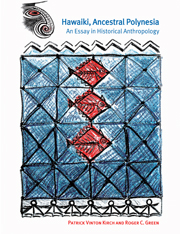Book contents
- Frontmatter
- Contents
- List of figures
- List of tables
- Preface
- List of language abbreviations
- Prologue: on historical anthropology
- Part I The phylogenetic model: theory and method
- Part II Rediscovering Hawaiki
- Introductory remarks
- 4 The Ancestral Polynesian world
- 5 Subsistence
- 6 Food preparation and cuisine
- 7 Material culture
- 8 Social and political organization
- 9 Gods, ancestors, seasons and rituals
- Epilogue: on history, phylogeny, and evolution
- Notes
- Glossary of terms
- References
- Subject Index
- Index of Proto Polynesian Reconstructions
8 - Social and political organization
Published online by Cambridge University Press: 06 January 2010
- Frontmatter
- Contents
- List of figures
- List of tables
- Preface
- List of language abbreviations
- Prologue: on historical anthropology
- Part I The phylogenetic model: theory and method
- Part II Rediscovering Hawaiki
- Introductory remarks
- 4 The Ancestral Polynesian world
- 5 Subsistence
- 6 Food preparation and cuisine
- 7 Material culture
- 8 Social and political organization
- 9 Gods, ancestors, seasons and rituals
- Epilogue: on history, phylogeny, and evolution
- Notes
- Glossary of terms
- References
- Subject Index
- Index of Proto Polynesian Reconstructions
Summary
Probably the term ariki was used as a chiefly title throughout Polynesia from the earliest times. The character of the oldest form of the Polynesian ariki chieftainship was perhaps more clearly sacerdotal. When the same term was later applied to a chief in the sense of a ruler, it marked a change. In time, a new type of arikiship evolved.
koskinen 1960:148Thus far in our program of applying a triangulation method to the “rediscovery” of Ancestral Polynesia within the framework of a phylogenetic model we have dealt with domains all having a material basis: the environment, subsistence, cuisine, and technology. We now move, however, largely out of this materialist realm, as we attempt to interpret fundamental social structures by which the Ancestral Polynesians organized themselves, as well as the belief systems – the mentalités – that regulated their daily lives. Archaeology will have only minimal input to these investigations, even though its contribution could potentially be much greater. To return to our surveying analogy, we are now restricted to fixing, by triangulation, the domain of interest from only two independent “lines of sight.” We must consequently depend more heavily on linguistic evidence for cultural (emic) categories, and will need to be as rigorous as possible in constructing semantic history hypotheses, informed by intensive ethnographic comparison. Such rugged terrain is not for the faint-hearted among culture historians. Yet we do not hesitate, for the landscape now within the scope of our surveying instruments – hazy though its topography may be – reveals the essential contours of ancient Polynesian societies.
- Type
- Chapter
- Information
- Hawaiki, Ancestral PolynesiaAn Essay in Historical Anthropology, pp. 201 - 236Publisher: Cambridge University PressPrint publication year: 2001

